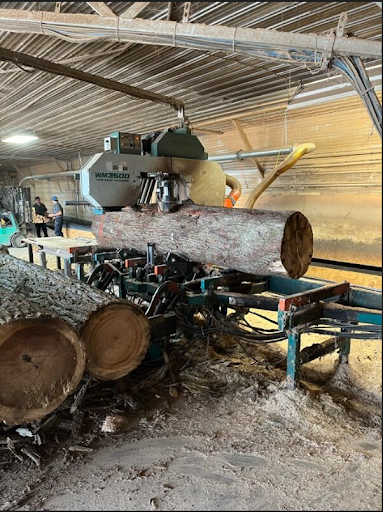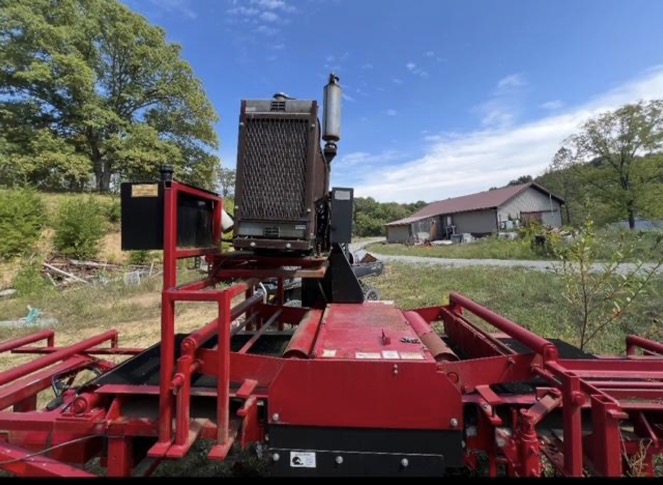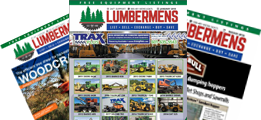Table of Contents Introduction: The First Line of Defense — Inspections Why Should Forestry Equipment Be Inspected Daily Before Operation? Why Is Regularly Inspecting the Equipment Important? What Is a Pre-Operation Inspection? Why Is It Important to Do a Pre-Operational Check-Up of Equipment? Equipment Inspection Procedure (Step-by-Step) Why Is It Important to Inspect Safety Equipment […]
The Complete Sawmill Maintenance Guide: Essential Equipment, Routine Tasks and Procedures That Extend Sawmill Lifespan
Table of Contents
- Introduction: Why Sawmill Maintenance Matters
- Sawmill Maintenance Equipment List
- Sawmill Maintenance Guide: Daily, Weekly & Monthly Tasks
- What Are the Items to Be Included in Routine Maintenance?
- What Are the Basic Maintenance Procedures for a Sawmill?
- Conclusion: Keeping Your Sawmill Running Smoothly
Key Takeaways:
- Sawmill maintenance extends machine lifespan and boosts productivity.
- Daily, weekly, and monthly schedules ensure no component gets overlooked.
- Keeping a logbook and using OEM parts helps prevent costly repairs.
Introduction: Why Sawmill Maintenance Matters
Let’s face it—your sawmill is the beating heart of your operation. Whether you’re running a commercial milling business or using it for personal lumber production, your sawmill needs consistent care to perform at its best. Neglecting maintenance doesn’t just shorten the life of your equipment—it hits your bottom line hard with unexpected downtime, repairs, and inefficiencies.
Just like a car needs oil changes or a chainsaw needs sharpening, your sawmill thrives on regular upkeep. And in the high-dust, high-vibration world of lumber milling, even small oversights can turn into big mechanical headaches.
In this blog, we’re going to walk through the complete sawmill maintenance strategy—from daily check-ups to monthly deep dives. By the end, you’ll know exactly what to look for, how often to do it, and what tools you’ll need to keep your sawmill running like a champ.
Sawmill Maintenance Equipment List
Before you start tightening bolts or greasing pulleys, you need the right tools on hand. A proper maintenance kit saves time and ensures that you’re using the correct equipment for each job. Here’s what every sawmill operator should have:
- Grease gun and lubricants (high-temp and water-resistant types):
A grease gun is essential for applying lubrication to bearings and other moving parts. Using the right type of grease—especially high-temperature and water-resistant varieties—helps prevent rust, wear, and overheating, especially in high-friction or outdoor environments. - Torque wrench for proper bolt tightening:
This tool ensures that bolts and fasteners are tightened to the manufacturer’s recommended torque specs. Over-tightening can strip threads or break parts, while under-tightening can cause critical components to loosen during operation. - Multimeter to check electrical connections:
A multimeter helps you test voltage, continuity, and resistance in the sawmill’s electrical system. It’s crucial for identifying wiring faults, dead circuits, or failing sensors before they cause downtime or safety risks. - Cleaning brushes and air compressor for sawdust removal:
Sawdust build-up can jam parts, reduce cooling efficiency, and even pose a fire hazard. Brushes help clean hard-to-reach areas, while a compressor blows debris out from motors, belts, and hydraulic systems without disassembling them. - Blade tension gauge:
Proper blade tension is critical for clean, accurate cuts and longer blade life. A blade tension gauge gives you a precise reading to ensure the blade is not too loose (causing drift) or too tight (leading to cracks). - Replacement parts like belts, bearings, and guide rollers:
Having spare parts on hand reduces downtime when wear-and-tear components need replacing. Belts transfer power, bearings allow smooth motion, and guide rollers keep the saw blade aligned—each of these must be in good condition for safe and efficient milling. - Logbook or maintenance software (UpKeep, Fleetio, or even a spreadsheet):
Tracking maintenance activities is key for long-term equipment health. Whether using a digital solution or a physical logbook, logging tasks, repairs, and part replacements keeps your maintenance routine organized and supports warranty claims or inspections.
Keeping these tools nearby ensures you’re ready to catch small issues before they snowball into downtime.
Sawmill Maintenance Guide: Daily, Weekly & Monthly Tasks
Think of this as your sawmill’s fitness routine. Each level of maintenance—daily, weekly, and monthly—plays a critical role in keeping your machine running efficiently.
Daily Maintenance – Your First Line of Defense
These are quick checks you should perform every time the sawmill is used. They help ensure safe operation and avoid minor issues becoming major repairs.
- Inspect the blade for cracks, wear, or pitch build-up:
A damaged blade can cause rough cuts, strain the motor, or even break during use. Look for any hairline cracks, dullness, or build-up of resin (pitch) that could affect cutting efficiency. Clean or replace the blade if needed. - Clean off sawdust and debris:
Sawdust accumulates quickly and can clog air intakes, reduce cooling efficiency, and create fire risks. Use brushes or compressed air to clear debris from around the engine, drive belts, rollers, and track. - Check fluid levels:
Top off engine oil, fuel, and coolant (if your sawmill uses a water-cooled engine). Running low on fluids can overheat the engine or damage components—easy to miss but costly if ignored. - Examine guide rollers and track system:
These ensure the blade stays aligned during cuts. Check for smooth rotation, unusual wear, or debris build-up that could cause the blade to wobble or drift.
Even just 10–15 minutes of daily maintenance can dramatically reduce unexpected breakdowns.
Weekly Maintenance – Deeper Performance Checks
Weekly inspections go beyond surface-level checks. They focus on key components that gradually loosen or wear out with regular use.
- Lubricate all moving parts:
Use your grease gun to apply lubricant to bearings, gears, and joints. This prevents friction damage and extends component life. Make sure to use the right type of grease—typically high-temp and water-resistant. - Tighten bolts and screws:
Continuous vibrations can slowly loosen fasteners, potentially causing breakdowns or dangerous failures. Go over key areas with a torque wrench and secure everything according to the specs. - Align drive belts:
Misaligned belts lead to uneven wear and power loss. Check for signs of slippage or fraying, and adjust the tension and alignment as needed to ensure smooth operation. - Inspect hoses for leaks or soft spots:
Look for hydraulic or fuel hose deterioration. Soft or swollen areas can signal internal breakdown, while visible cracks or leaks should be addressed immediately to avoid pressure loss or safety hazards.
Weekly attention catches wear and tear early—before it becomes expensive damage.
Monthly Maintenance – The Full Sawmill Check-Up
Monthly inspections are your chance to look at the big picture and address areas that aren’t immediately visible during daily use.
- Inspect bearings and pulleys:
Worn bearings can grind, heat up, or seize. Listen for grinding noises, feel for resistance, and check for wobbling. Replace any bearing that doesn’t move freely. Also, inspect pulleys for cracks or imbalance. - Check hydraulic systems:
Look over the entire hydraulic system including pumps, hoses, and cylinders. Watch for slow movement, whining sounds, or oil leaks. Maintaining hydraulic pressure is critical for safety and performance. - Inspect electrical connections:
Over time, wiring can become loose or corroded, especially in outdoor environments. Check plugs, terminals, and wiring for rust, fraying, or discoloration. Clean connections and replace any suspect components. - Examine the log deck and loader arms:
These parts bear heavy loads and are prone to bending or cracking over time. Look for stress marks, broken welds, or misalignment that could affect log feeding and overall cutting accuracy.
Monthly inspections are about ensuring the long-term health of your mill—don’t skip them if you want consistent performance.It should be documented in your logbook and followed up with any required part replacements.
What Are the Items to Be Included in Routine Maintenance?
Routine maintenance isn’t just about oil changes—it’s about systematically checking every part of the machine that affects performance and safety. Here’s a detailed look:
-
Sawmill Blade and Guide Rollers
The blade is the heart of your sawmill. If it’s dull, cracked, or misaligned, it won’t cut straight, and it could overheat—burning the wood or stressing the motor. Guide rollers keep the blade stable and aligned as it moves. Check them daily for smooth rotation, proper tension, and buildup of debris. Replace blades regularly and clean resin off the rollers to maintain cutting precision.
-
Hydraulic Pumps and Hoses
Your hydraulic system powers log lifts, clamps, and other moving parts. Leaking hoses, cracking seals, or sluggish movement are early signs of wear. Regularly inspect for fluid leaks, soft spots in hoses, or changes in pressure. A sudden drop in hydraulic pressure can halt operations and damage components. Replace aging hoses before they burst to keep your system strong and responsive.
-
Engine and Motor Systems
The engine must run smoothly for the sawmill to perform consistently. Strange noises like knocking, sputtering, or whining can indicate serious issues. Check oil and fuel levels daily, clean or replace air filters as needed, and inspect spark plugs for wear or fouling. A well-maintained engine is not only efficient but also extends the life of the entire machine.
-
Bearings, Belts, and Pulleys
These are your power-transmitting components. Bearings allow for smooth motion; belts transfer energy; pulleys help guide and drive movement. If you hear grinding or feel excessive vibration, bearings may be worn. Frayed or slipping belts reduce efficiency and can snap unexpectedly. Inspect these parts regularly for heat buildup, cracks, or slippage and replace them as soon as issues appear.
-
Electrical Connections and Controls
Electrical systems keep your sawmill responsive and safe. Any loose wires, corrosion, or broken switches can create serious hazards—like failure to start or even electrical fires. Test switches, emergency stops, and control panels routinely. Check all wiring for insulation damage or rusted terminals. Cleaning and tightening connections helps prevent short circuits and costly downtime.
A good routine makes it easier to spot patterns and prevent repeat issues.
What Are the Basic Maintenance Procedures for a Sawmill?
Now let’s break it down step-by-step. These are your go-to procedures:
- Blade Tensioning and Sharpening: Check blade tension before each use. Blade tension is critical for accurate cuts and machine safety. A loose blade can wobble, create uneven cuts, and even derail. Always check and adjust the blade tension before each use according to your manufacturer’s specs. Use a sharpening tool or send blades out for professional service depending on wear.
- Cleaning and Greasing Moving Parts: Clean after every job to remove resin and dust. Every time you finish milling, sawdust, resin, and wood chips collect on the machine’s moving parts. This debris causes friction, traps moisture, and can lead to corrosion or premature wear. Use compressed air or brushes to thoroughly clean the mill, especially the track, bearings, and blade housing. Then, at least once a week, apply grease to key points—bearings, pivot arms, and slide rails—to ensure smooth operation and extend the life of your sawmill components. Clean machines not only run better—they also help you spot issues early.
- Replacing Worn Components: From belts to bushings, always use OEM (Original Equipment Manufacturer) parts for best fit and durability. Over time, parts like belts, bushings, bearings, and seals naturally wear out due to heat, friction, and repetitive motion. When it’s time to replace them, always opt for OEM (Original Equipment Manufacturer) parts rather than cheaper aftermarket alternatives. Why? Because OEM parts are designed specifically for your sawmill’s make and model—they fit perfectly, last longer, and preserve the machine’s performance. Aftermarket parts might seem like a bargain, but they can lead to poor alignment, faster wear, or even mechanical failure. Investing in OEM components ensures your sawmill stays reliable, safe, and efficient.
- Engine Oil and Filter Changes: Change oil based on operating hours. The engine is the powerhouse of your sawmill, and oil is its lifeblood. Over time, oil breaks down and collects debris, reducing its ability to lubricate and cool the engine. Change the oil according to the manufacturer’s recommended operating hours—typically every 25–50 hours. Also, regularly clean or replace air and oil filters to prevent dust, sawdust, and contaminants from clogging the system. Dirty filters can choke the engine, reduce power, and cause overheating or long-term damage.
- Record Keeping: Use a maintenance logbook or app to track what was done and when. A maintenance logbook—whether physical or digital—is more than just paperwork. It gives you a clear history of what work has been done, what parts were replaced, and when your next service is due. This documentation helps you plan maintenance proactively, avoid repeated issues, and protect your equipment’s value. It’s also essential for warranty claims, as many manufacturers require proof of regular maintenance before honoring repairs or part replacements.
- Reminders and Schedules: Set digital reminders or use a visible wall calendar to stick to your schedule. Consistency is key.Even the best maintenance plan is useless if you forget to follow it. Use tools like mobile apps (e.g., UpKeep, Fleetio) or simply a big calendar in your workshop to mark key service dates. Set reminders for oil changes, blade sharpening, and monthly inspections. Staying consistent helps you catch small problems early, avoid unexpected downtime, and keep your sawmill in peak working condition year-round.
These practices, though simple, make a big difference in your sawmill’s performance over time.
Conclusion: Keeping Your Sawmill Running Smoothly
A well-maintained sawmill isn’t just a better machine—it’s a smarter investment. With regular inspections, scheduled maintenance, and a little bit of discipline, your sawmill will deliver consistent results for years to come.
Neglect leads to breakdowns, but routine care builds reliability. Plus, it supports resale value, warranty coverage, and overall shop safety.
So whether you’re milling full-time or just on weekends, a maintenance plan ensures every board you cut is a clean one—and every job is finished without the stress of unexpected repairs.
Treat your sawmill like a partner, not just a machine—and it’ll return the favor with reliable, long-term service.
FAQ’S
What is sawmill maintenance, and why is it important?
Sawmill maintenance involves regularly inspecting, cleaning, and servicing machinery to prevent breakdowns, improve efficiency, and extend equipment lifespan.
What tools are needed for sawmill maintenance?
Essential tools include blade sharpeners, lubricants, wrenches, belt tension gauges, air compressors, grease guns, and alignment tools.
How often should I maintain my sawmill?
Maintenance should be performed daily, weekly, and monthly, depending on usage intensity and the manufacturer’s guidelines.
What’s included in a daily sawmill maintenance checklist?
Daily tasks include cleaning sawdust, checking blade tension, inspecting fluids, and ensuring all moving parts are properly lubricated.
How do I create a sawmill maintenance schedule?
Base it on usage hours, equipment type, and manufacturer recommendations. Break it down into daily, weekly, and monthly intervals.
What are common signs that sawmill maintenance is overdue?
Signs include uneven cuts, increased vibration, overheating, and unusual noises or blade wear.
What are the most common maintenance issues in sawmills?
Blade dullness, misalignment, worn belts, hydraulic leaks, and debris buildup are frequent problems.
How can I extend the life of my sawmill blades?
Sharpen regularly, clean after each use, maintain correct tension, and avoid hitting dirty or metal-laced logs.
Is it better to use OEM or aftermarket parts for maintenance?
OEM parts are generally recommended for better performance, compatibility, and warranty compliance, though high-quality aftermarket options may be viable.
Can I perform sawmill maintenance myself, or should I hire a technician?
Many tasks can be done by operators with basic mechanical knowledge. However, complex hydraulic or electrical repairs may require a professional.





